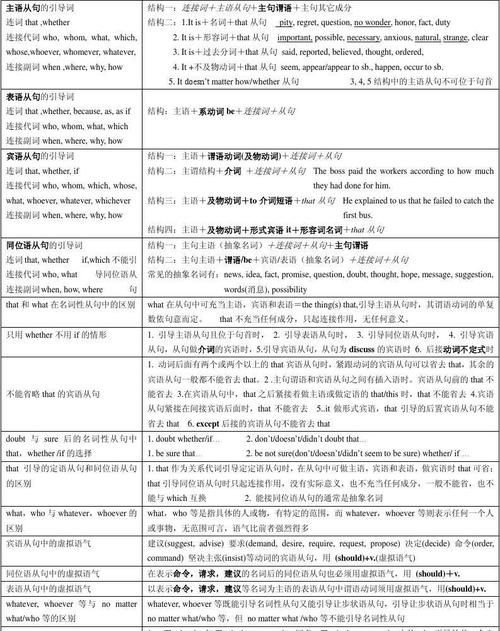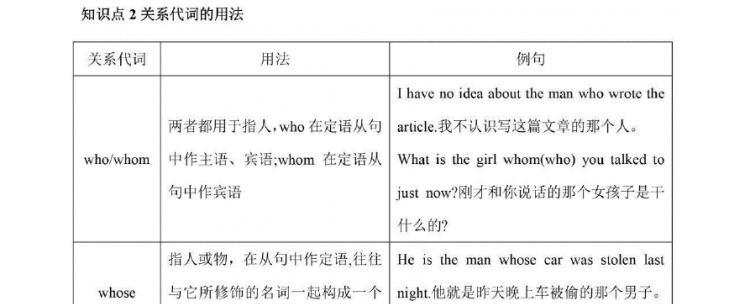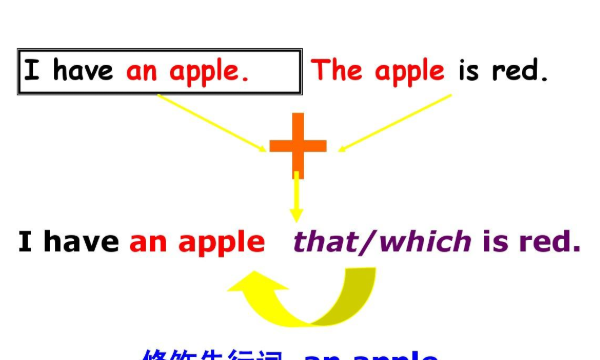本文目录
详细举例讲一讲各种英语从句的用法
一.主语从句
主语从句是在复合句中充当主语的从句,通常放在主句谓语动词之前或由形式主语it代替,而本身放在句子末尾.
1. It 作形式主语和it引导强调句的比较
It 作形式主语代替主语从句,主要是为了平衡句子结构,主语从句的连接词没有变化.而it引导的强调句则是对句子某一部分进行强调,无论强调的是什么成分,都可用连词that.被强调部分指人是也可用who/whom.例如:
It is a pity that you didn’t go to see the film.
It doesn’t interest me whether you succeed or not.
It is in the morning that the murder took place.
It is John that broke the window.
2. 用it 作形式主语的结构
(1) It is +名词+从句
It is a fact that … 事实是…
It is an honor that …非常荣幸
It is common knowledge that …是常识
(2) it is +形容词+从句
It is natural that… 很自然…
It is strange that… 奇怪的是…
(3) it is +不及物动词+从句
It seems that… 似乎…
It happened that… 碰巧…
(4) it +过去分词+从句
It is reported that… 据报道…
It has been proved that… 已证实…
3. 主语从句不可位于句首的五种情况
(1) if 引导的主语从句不可居于复合句句首.
(2) It is said , (reported) …结构中的主语从句不可提前.例如:
It is said that President Jingo will visit our school next week. (right)
That President Jiang will visit our school next week is said. (wrong)
(3) It happens…, It occurs… 结构中的主语从句不可提前.例如:
It occurred to him that he failed in the examination. (right)
That he failed in the examination occurred to him. (wrong)
(4) It doesn’t matter how/whether …结构中的主语从句不可提前.例如:
It doesn’t matter whether he is wrong or not. (right)
Whether he is wrong or not doesn’t matter. (wrong)
(5) 含主语从句的复合句是疑问句时,主语从句不可提前.例如:
Is it likely that it will rain in the evening? (right)
Is that will rain in the evening likely? (wrong)
4. What 与that 在引导主语从句时的区别
What 引导主语从句时在句时在从句中充当句子成分,如主语.宾语.表语,而that 则不然.例如:
1) What you said yesterday is right.
2) That she is still alive is a consolation.
二.宾语从句
宾语从句就是在复合句中作宾语的名词性从句,通常放在主句谓语动词(及物动词)或介词之后.
1. 作动词的宾语
(1) 由that引导的宾语从句(that 通常可以省略),例如:
I heard that be joined the army.
(2) 由what, whether (if) 引导的宾语从句,例如:
1) She did not know what had happened.
2) I wonder whether you can change this note for me.
(3) 动词+间接宾语+宾语从句.例如:
She told me that she would accept my invitation.
2. 作介词的宾语
例如:Our success depends upon how well we can cooperate with one another.
3. 作形容词的宾语
例如:I am afraid (that) I’ve made a mistake.
That 引导的从句常跟在下列形容词后作宾语:
Anxious, aware, certain, confident, convinced, determined, glad, proud, surprised, worried, sorry, thankful, ashamed, disappointed, annoyed, pleased, hurt, satisfied, content 等.也可以将此类词后的that 从句的看作原因状语从句.
4. It 可以作为形式宾语
It 不仅可以作为形式主语,还可以作为形式宾语而真正的宾语that 从句则放在句尾,特别是在带复合宾语的句子中. 例如:
We heard it that she would get married next month..
5. 后边不能直接跟that 从句的动词
这类动词有Allow, refuse, let, like, cause, force, admire, condemn, celebrate, dislike, love, help, take, forgive等.这类词后可以用不定式或动名词作宾语,但不可以用that引导的宾语从句.例如:
I admire their winning the match. (right)
I admire that they won the match. (wrong)
6. 不可用that从句作直接宾语的动词
有些动词不可用于“动词+间接宾语+that从句“结构中,常见的有Envy, order, accuse, refuse, impress, forgive, blame, denounce, advise, congratulate等.例如:
He impressed the manager as an honest man. (right)
He impressed the manager that he was an honest man. (wrong)
7. 否定的转移
若主句谓语动词为Think, consider, wuppose, believe, expect, fancy, guess, imagine等,其后的宾语从句若含有否定意义,一般要把否定词转移到主句谓语上,从句谓语用肯定式.例如:
I don’t think this dress fits you well.(我认为这件衣服不适合你穿.)
三.表语从句
表语从句在复合句中作表语的名词性从句,放在系动词之后,一般结构是“主语+连系动词+表语从句”.可以接表语从句的连系动词有be, look, remain, seem等.引导表语从句的that常可省略.另外,常用的还有the reason is that… 和It is because 等结构.例如:
1) The question is whether we can make good preparation in such a short time.
2) This is why we can’t get the support of the people
3) But the fact remains that we are behind the other classes.
4) The reason he is late for school is that he missed the early bus.
四.同位语从句
同位语从句就是在复合句中作名词的同位语的名词性从句.
1. 同位语从句的功能
同位语从句对于名词进一步解释,说明名词的具体内容,一般由that引导,例如:
1) The king’s decision that the prisoner would be set free surprised all the people.
2) The order that all the soldiers should stay still is given by the general.
2. 同位语在句子中的位置
同位语从句有时可以不紧跟在它所说明的名词后面,而是被别的词隔开.例如:
He got the news from Mary that the sports meeting was put off.
3. 同位语从句与定语从句的区别
(1) 定语从句中的that既代替先行词,同时以在从句中作某个成分(主语或宾语),而同位语从句中的that是连词,只起连接主句与从句的作用,不充当句中任何成分.
(2) 定语从句是形容词性的,其功能是修饰先行词,对先行词加以限定,描述定的性质或特征;同位语从句是名词性的,其功能是对名词进行补充说明.例如:
1) The news that he told me is that Tom would go abroad next year.(他告诉我的消息是汤姆明年将出国.)(第一个that引导的从句是定语从句,that在从句中作宾语)
2)The news that Tom would go abroad is told by him.(汤姆将出国的消息是他讲的.)(同位语从句,that在句中不作任何成分)

英语从句的讲解和例子PPT
英语从句分为名词性从句,形容词性从句(定语从句),以及状语从句。例如结果状语从句:He was so angry that he couldn't speak. 他气得话都说不出来。,从句体系包括:,名词性从句(主语从句、表语从句、宾语从句及同位语从句)、定语从句、状语从句,分类:,从句不能单独成句,但它也有主语部分和谓语部分,是一个特殊句子,就像一个句子一样。所不同在于,从句须由一个关联词引导。,根据从句语法功能的不同可分为:主语从句、表语从句、宾语从句、同位语从句、定语从句和状语从句6类。,前四类由于主语从句、表语从句、宾语从句及同位语从句在句子的功用相当于名词,所以通称 名词性从句 ;,定语从句功能相当于形容词,称为 形容词性从句 ;而状语从句功能相当于副词,称为 副词性从句 。,状语从句还可以分为条件状语从句、原因状语从句、地点状语从句、目的状语从句、让步状语从句、比较状语从句、方式状语从句、结果状语从句和时间状语从句。, 主语从句 (Subject Clause),用作主语的从句叫主语从句。引导主语从句的关联词有从属连词、疑问代词、疑问副词、缩合连接代词、缩合连接副词等。, 表语从句 (Predicative Clause),用作表语的从句叫做表语从句。引导表语从句的关联词与引导主语从句的关联词很多都一样。, 宾语从句 (Object Clause),在句子中起宾语作用的从句叫做宾语从句.宾语从句分为三类:动词的宾语从句、介词的宾语从句和形容词的宾语从句。, 同位语从句 ,是名词性从句(主语从句、表语从句、宾语从句、同位语从句)中的主要从句之一,从句作同位语表示与之同位的名词(短语)的实际内容,它的作用相当于名词,对前面的名词(短语)加以补充说明或进一步解释,相当于一个表语从句,它们之间的关系就是同位关系,即主表关系。, 定语从句 ,是由关系代词或关系副词引导的从句,其作用是作定语修饰主句的某个名词性成分,相当于形容词,所以又称为形容词性从句,一般紧跟在它所修饰的先行词后面。, 状语从句 ,时间状语从句(adverbial clause of time),地点状语从句(adverbial clause of place),原因状语从句(adverbial clause of cause),条件状语从句(adverbial clause of condition),目的状语从句(adverbial clause of purpose),让步状语从句(adverbial clause of concession),比较状语从句(adverbial clause of parison),方式状语从句(adverbial clause of manner),结果状语从句(adverbial clause of result),英语八类状语从句的用法归纳,一、概说,状语从句即指在主从复合句用作状语的从句。按照其意义,状语从句可分为时间状语从句、地点状语从句、原因状语从句、目的状语从句、结果状语从句、条件状语从句、让步状语从句等。状语从句是高中英语学习中的一个语法重点,也是历年高考重点考查的内容之一。学习状语从句主要应注意引导状语从句的从属连词的用法与区别,以及从属连词在一定的语言环境中的意义与用法。,二、 时间状语从句 ,1. 引导时间状语从句的从属连词很多,常见的有before, after, when, while, as, since, till, until, as soon as 等。,2. 表示“当…时候”的 while, when, as 的用法区别是:while从句中的谓语动词必须是延续性动词;表示带有规律性的“每当”或当主、从句谓语动词的动作发生有先后时,只能用 when;当表示“一边…一边…”或“随着”时,只能用 as。另外,用于此义的 as 所引导的时间状语从句谓语只能是动作动词,不能是状态动词。如下面一道高考题的答案是 B 而不能是A:,“I’m going to the post office.” “_____ you’re there, can you get me some stamps?”,A. As B. While C. Because D. If,3. until 在肯定句中通常只连用延续性动词,表示相应动作结束的时间;在否定句中通常连用非延续性动词,表示相应动作开始的时间,意为“直到…才”。如:,He waited until she was about to leave. 他等着一直到她准备离开。,I did not begin to work till he had gone. 他走了后我才开始工作。,4. 表示“一…就”除用 as soon as 外,还可用 the minute, the second, the instant, immediately, directly, instantly, no sooner…than, hardly…when 等。如:,I came immediately you called. 你一来电话我就来了。,Hardly had she arrived when it began to snow. 她刚到就下起雪来了。,The moment I have finished I'll give you a call. 我一干完就给你打电话。,5. every time, each time, (the) next time, (the) last time, by the time, the first time, any time 等以 time 结尾的词语也可用作连词,引导时间状语从句。如:,Next time you e in, please close the door. 下次你进来,请关门。,He didn’t tell me anything the last time I saw him. 上次我见到他时他什么也没告诉我。,By the time I got home, she had already gone to bed. 我到家时她已睡觉了。,三、 条件状语从句 ,1. 引导条件状语从句的从属连词主要有 if, unless, as [so] long as等。如:,Don’t e unless I telephone. 除非我打电话,否则你别来。,If you watch carefully you will see how to do it. 如果你仔细瞧你会看出该怎样做。,As long as you do your best, we’ll be happy. 只要你尽力,我们就满意了。,2. in case 也可引导条件状语从句,其意为“如果”、“万一”。如:,In case I fet, please remind me about it. 如果我忘了,请提醒我。,四、 让步状语从句 ,1. 引导让步状语从句的从属连词主要有 although, though, however (=no matter how), even if(即使), whether…or(不论…还是)等连词。如:,The speech is good, though it could be better. 这次演讲不错,虽然还可以再好一点。,He went out even though it was raining. 尽管下雨,他还是出去了。,2. as 也可引导让步状语从句,但要将名词、形容词或副词等提到 as 前,若提前的是单数可数名词,要省略 a / an。如:,Teacher as he is, he can’t know everything. 虽然是老师,他也不可能什么都懂。,3. 连词 while 有时也可表示“尽管”、“虽然”,引导让步状语从句。如:,While we don’t agree we continue to be friends. 尽管我们意见不同,我们还是朋友。,4. whatever, whoever, however, whenever, wherever 等引导让步状语从句。如:,Don’t lose heart whatever you do. 不管你做什么,都不要灰心。,Whoever you are, you can’t pass this way. 不管你是谁,你都不能从这里通过。,注:表示“虽然”的 though, although 不可与 but 连用,但可与 yet, still 连用。,五、 原因状语从句 ,1. 引导原因状语从句的从属连词主要有because, as, since, seeing (that), now (that)等:,They can’t have gone out because the light’s on. 他们不可能出去了,因为灯还亮着。,Since you are going, I will go. 既然你去,我也去。,Now that we are alone, we can speak freely. 现在我们单独在一起,可以随便谈了。,2. 除以上提到的大家比较熟悉的引导原因状语从句的从属连词外,when有时也可引导原因状语从句,其意“既然”。如:,I can’t tell you when you won't listen. 既然你不想听,我就不告诉你了。,3. 有关原因状语从句还应注意以下几点:,(1) as 与 since, now that 一样表示双方都知道的原因,通常位于主句前,且均不可用于强调结构被强调。,(2) 当表示直接的因果关系,回答 why 时,或有 only, just, all, partly, not, but 等副词修饰时,或用在强调结构中都只能用 because。,(3) for 有时也可引出表示原因的分句,但它只能位于后面,对前一分句加以解释或推断。,(4) 不要受汉语意思影响将表示“因为”的连词与表示“所以”的 so 连用。,六、 地点状语从句 ,引导地点状语从句的从属连词主要有where (在…的地方), wherever(无论什么地方), everywhere(每个…地方), anywhere(任何…地方)。如:,I’m not living where I was. 我不在原处住了。,You can’t camp where [wherever, anywhere] you like these days. 如今你可不能随便在哪儿宿营。,Everywhere I go, I find the same thing. 不管我走到哪里,我都发现同样情况。,2. 有的同学认为地点状语从句在平时见得不多,误认为考试不会涉及,但恰恰相反,地点状语从句却是英语考试经常考查的一个知识点。请看以下考题:,(1) When you read the book, you’d better make a mark _____ you have any questions.,A. at which B. at where C. the place where D. where,(2) After the war, a new school building was put up _____ there had once been a theatre.,A. that B. where C. which D. when,(3) You should make it a rule to leave things _____ you can find them again.,A. when B. where C. then D. there,(4) She found her calculator ______ she lost it.,A. where B. when C. in which D. that,以上四题均选where,其意为“在…的地方”,用以引导地点状语从句。,七、 目的状语从句 ,1. 引导目的状语从句的从属连词主要有 in order that, so that, in case, for fear等。如:,I hired a boat so that I could go fishing. 我租了一条船去钓鱼。,Take your coat in case it rains (should rain). 带着雨衣以防下雨。,He studied hard in order that he could pass the exam. 他努力学习,是为了能通过考试。,2. 引导目的状语从句的 so that 有时可省so 或 that,即单独用 so 或 that 来引导目的状语从句。如:,Check carefully, so any mistake will be caught. 仔细检查,以便任何错误都可检查出。,Bring it closer that I might see it better. 拿近些,使我能看得清楚些。,八、 结果状语从句 ,引导结果状语从句的从属连词主要有so that, so…that, such…that等。如:,He was so angry that he couldn't speak. 他气得话都说不出来。,He shut the window with such force that the glass broke. 他关窗子用力很大,结果玻璃震破了。,注:so…that和such…that中的that有时(尤其在口语中)可省略。

英语八大从句类型与用法总结PPT
根据从句语法功能的不同可分为:主语从句、表语从句、宾语从句、同位语从句、定语从句和状语从句6类。
1、主语从句
主语从句就是作主语的从句。它的连接词有连词、连接副词、连词代词。主语从句放在句首时,句子显得很笨重,因此常用it作形式主语,而将真正的主语后置,比如:
It is a pity that you have missed such a wonderful concert.
真遗憾你错过了这么精彩的一场音乐会。
2、表语从句
表语从句就是作表语的从句。它的连接词有连词、连接副词、连词代词等。
比如:
My idea is that we meet at the bus stop.
我的想法是我们在公共汽车站会面。
3、宾语从句
宾语从句就是作宾语的从句。它的连接词有连词、连接副词、连词代词等。
比如:
She said that she would drop maths.
她说她要放弃数学。

4、同位语从句
同位语从句就是作同位语的从句,它的连接词有连词、连接副词等。
The fact that everyone loves beauty is common sense.
人人爱美是常识。
5、定语从句
定语从句就是作定语的从句。定语从句主要修饰、限定、描绘名词,有时修饰代词,放所修饰词后边。
比如:
The girl who wears a new dress is my daughter.
那个穿新衣服的女孩是我的女儿。
6、状语从句
状语从句就是作状语的从句。在复合句中修饰主句中的谓语动词、形容词或副词,起状语作用的从句叫作状语从句。
比如:
Soon after he jumps his parachute will open.
他跳伞之后,降落伞就会打开。
英语从句句型有哪几种类型
英语中从句有6类,分别为:主语从句、表语从句、宾语从句、同位语从句、定语从句和状语从句。
1、主语从句(Subject Clause)
用作主语的从句叫主语从句。引导主语从句的关联词有从属连词、疑问代词、疑问副词、缩合连接代词、缩合连接副词等。
2、表语从句(Predicative Clause)
用作表语的从句叫做表语从句。引导表语从句的关联词与引导主语从句的关联词很多都一样。
3、宾语从句(Object Clause)
在句子中起宾语作用的从句叫做宾语从句。宾语从句分为三类:动词的宾语从句、介词的宾语从句和形容词的宾语从句。

4、同位语从句
是名词性从句(主语从句、表语从句、宾语从句、同位语从句)中的主要从句之一,从句作同位语表示与之同位的名词(短语)的实际内容,它的作用相当于名词,对前面的名词(短语)加以补充说明或进一步解释,相当于一个表语从句,它们之间的关系就是同位关系,即主表关系。
5、定语从句
是由关系代词或关系副词引导的从句,其作用是作定语修饰主句的某个名词性成分,相当于形容词,所以又称为形容词性从句,紧跟在它所修饰的先行词后面。
6、状语从句
用作状语的从句叫作状语从句,其关联词是一些从属连词。修饰主句中的动词、形容词和副词,通常由从属连词引导,按其意义和作用可分为时间、地点、 条件、 原因、让步、目的、结果、 方式、比较状语从句等。
以上就是关于英语有哪些从句类型带例子,详细举例讲一讲各种英语从句的用法的全部内容,以及英语有哪些从句类型带例子 的相关内容,希望能够帮到您。
